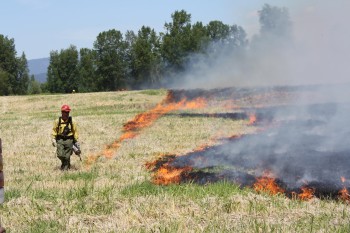Management
The Columbia River Gorge wildland-urban interface includes 13 incorporated communities, 4+ unincorporated communities, numerous state parks, National Wildlife Refuges, fish hatcheries and tribal allotments. The National Scenic Area borders Mt. Hood National Forest in Oregon and Gifford Pinchot National Forest in Washington. Two full time Forest Service initial attack engines cover more than sixty miles of the Gorge and we often get multiple starts a day during fire season. In other words, cooperation with our partners is critical! Thankfully, we work with almost 40 fire cooperators.
This includes state partners such as Washington Department of Natural Resources and Oregon Department of Forestry, federal partners including Bureau of Land Management, U.S. Fish and Wildlife Service, Bureau of Indian Affairs, and many local Fire Districts and Municipal Departments throughout the Gorge.
Year Round Management
Our team includes full-time firefighters and part-time support from employees in other resource areas, and we work year round with partners to combat wildfire while also using fire as a tool for ecological restoration.
Throughout the year, we provide educational and outreach programs in classrooms and at community events, focused on fire prevention. Smokey Bear often shows up to our events, reminding people that we need their help to prevent unwanted fires. Most wildfires in the Gorge are human caused, so this important message is still relevant.
During fire season, aggressive fire suppression is important. When conditions are dry, seasonal fire restrictions go into effect. You will often see our three-letter designator CGF on the side of Forest Service vehicles, as we patrol and respond to fires. When major fires hit, we work with the Northwest Interagency Coordination Center and National Interagency Fire Center to order additional resources.
When fire season winds down, our fire team looks for opportunities to use fire as a management tool. At the tail-end of fire season, we often conduct under-burns before it gets too wet for fire to carry. This is a controlled burn between pre-established lines with very specific fire intensity objectives. We may be trying to thin out underbrush or small trees, harden the cambium on Ponderosa pines or reduce flashy woody debris and grasses.
Then after the ground becomes too wet to support fire, we move into pile burning. Areas that have not seen gentle fire in a long period have so much undergrowth that they cannot safely be treated with an under-burn. In places with a large concentration
of fuels, we will thin with chainsaws or other equipment and stack the cut small trees in piles that we can later burn. After the piles cure for a year or two, in order to reduce the potential smoke, we pick appropriate conditions for pile burning so we can ensure the burn doesn’t escape, and the impact from smoke is minimized.
As snow melts in the spring, our fire team helps fell hazard trees and sometimes joins up with recreation to clear and repair trails. Half of the program’s tree climbing work is dealing with hazard trees and the other half is improving habitat for different species.




